The Most Reverend OFM Conv.
as Fifth Bishop of Charlotte

as Fifth Bishop of Charlotte
Wednesday, the Twenty-Ninth of May, Two Thousand Twenty-Four One o’clock in the afternoon
The Episcopal Ordination of Saint Mark Catholic Church Huntersville, North Carolina
To the good people of Western North Carolina: Martin Luther King, Jr., is remembered to have said: “Take the first step in faith. You don’t have to see the whole staircase, just take the first step.” Today we all take a step together in faith. While none of us can see the whole staircase, I am so grateful to walk it together with you!
— Bishop Michael T. Martin
A la buena gente del oeste de Carolina del Norte: se recuerda que Martin Luther King, Jr., dijo: “Den el primer paso con fe. No es necesario que vean toda la escalera, simplemente den el primer paso”. Hoy todos damos un paso juntos con fe. Aunque ninguno de nosotros pueda ver toda la escalera, ¡estoy muy agradecido de recorrerla junto a ustedes!
— Obispo Michael T. Martin
Kính thưa quý ông bà và anh chị em ở miền tây của bang North Carolina, Ông Martin Luther, Jr., được nhớ đến với câu nói: “Bạn hãy vững tin khi đi bước đầu tiên. Bạn không nhất thiết phải nhìn thấy toàn bộ cầu thang, bạn chỉ cần đi bước đầu tiên.” Hôm nay tất cả chúng ta cùng nhau bước đi trong đức tin. Cho dù không ai trong chúng ta có thể nhìn thấy toàn bộ cầu thang, tôi rất cảm kích và biết ơn vì được bước đi cùng với anh chị em!
— Giám Mục Michael T. Martin
마틴 루터 킹 주니
어 목사는 이런 말을 남겼습니 다. “믿음으로 첫걸음을 내딛 으세요. 계단 전체를 보려고 하
지 않아도 됩니다. 그냥 첫발을
내딛으세요.” 오늘 우리 모두
는 믿음으로 한 걸음씩 함께 나 아갑니다. 우리 중 누구도 계단 전체를 볼 수는 없지만, 여러분 과 함께 걸을 수 있어서 정말 감사합니다!
마이클 마틴주교
FRENCH
Aux bonnes gens de l’ouest de la Caroline du Nord: On se souvient de Martin Luther King, Jr., d’avoir declaré: Faite le premier pas dans la foi. Vous n’avez pas besoin de voir tout l’escalier, faites simplement le premier pas. Aujourd’hui, nous faison tous un pas ensemble dans la foi. Même si aucun de nous ne peut voir l’escalier en entier, je suis très reconnaissant de le parcourir avec vous!
— Monseigneur Michael T. Martin
Шановні добрі люди Західної Північної
TAGALOG/FILIPINO
Sa mga mabubuting tao ng Kanlurang Hilagang Carolina: Naalaala si Martin Luther King, Jr., na nagsabi: “Gawin ang unang hakbang sa pananampalataya. Hindi mo kailangang makita ang buong hagdanan, basta’t gawin mo ang unang hakbang.” Ngayon, tayo ay maglalakbay ng sabay-sabay na may pananampalataya. Bagaman walang isa sa atin ang makakakita ng buong hagdanan, lubos akong nagpapasalamat na kasama ko kayo sa paglalakbay na ito.
— Obispo Michael T. Martin
Continued on the inside back page >>
Maka unu ezigbo ndi Ndida ugwu North Carolina. Ana echeta okwu
Martin Luther King Jr. dika okwuru si: “Zoo ukwu njem mbu nke okwukwe. Odighi mkpa ihutacha uzo njem ahu niile. Ihe di mkpa bu izo ukwu mbu nke okwukwe.” N’ubochi taa anyi niile azoola ukwu njem okwukwe ahu. Mgbe n’enweghi onye n’ime anyi nwere Ike ihutacha uzo niile nke njem a. Omasiri m nke ukwuu isonye unu zoo ukwu njem a.
— Nnukwu Ukochukwu Michael T.
Martin
AMHARIC
Kwa watu wema wa Magharibi mwa North Carolina: Martin Luther King, Jr., anakumbukwa kusema: “Chukua hatua ya kwanza katika imani. Si lazima uone ngazi nzima, chukua hatua ya kwanza tu.” Leo sisi sote tunapiga hatua pamoja katika imani. Ingawa hakuna hata mmoja wetu anayeona ngazi nzima, nashukuru sana kutembea pamoja nanyi!
— Askofu Michael T. Martin
BRAZILIAN PORTUGUESE
Para as boas pessoas do Oeste da Carolina do Norte: Martin Luther King Jr. é lembrado por ter dito: “Dê o primeiro passo com fé. Você não precisa ver toda a escadaria, apenas dê o primeiro passo.” Hoje, todos nós damos um passo juntos com fé. Embora nenhum de nós possa ver toda a escadaria, estou muito grato por poder percorrê-la junto com você!
— Bispo Michael T. Martin
TIGRINYA
Do wszystkich ludzi dobrej woli z zachodniej części stanu Karolina
Północna: Martin Luther King Jr. wyrzekł te pamiętne słowa: „Uczyń pierwszy krok z wiarą. Nie musisz widzieć całych schodów, uczyń tylko pierwszy krok”. Dziś, z wiarą wspólnie stawiamy pierwszy krok. Choć nikt z nas nie widzi całych schodów, to jestem pełen wdzięczności, że możemy po nich kroczyć razem.
— Biskup Michael T. Martin
BURMESE
အနောက်မြောက်ကာရိုလိုင်း နားရှိ
“ယုံကြည်ခြင်းအတွက်ဂျူနီယာက ပထမ ခြေလှမ်းကို လှေကားတစ်ခုလုံးကိုလှမ်းလိုက်ပါ။မမြင်ရ ပါဘူး၊ ပထမခြေလှမ်းသာ လှမ်း လိုက်ပါ။” ယနေ့ကျွန်ုပ်တို့ အားလုံး ခြေတစ်လှမ်းယုံကြည်ခြင်း၌လှမ်းကြသည်။ လှေကားတစ်ခုလုံးကို ဘယ်သူ မှ မမြင်နိုင်ပေမဲ့ လမ်းလျှောက်ရတာမင်းနဲ့အတူတူ အရမ်း ကျေးဇူးတင်တယ်။ — ဘုန်းတော်ကြီး မိုက်ကယ် တီ. မာတင်
MALAYALAM പടിഞ്ഞാറൻ
 by Principal Consecrator
by Principal Consecrator
The Most Reverend Gregory J. Hartmayer, OFM Conv. Metropolitan Archbishop of Atlanta and
His Eminence Christophe Cardinal Pierre Apostolic Nuncio to the United States of America
The Most Reverend Peter J. Jugis Fourth Bishop of Charlotte
in the presence of Bishops, Priests and Deacons of Charlotte, Atlanta, Baltimore, Charleston, Raleigh and Savannah
The Very Reverend Michael Heine, OFM Conv.
The Reverend Jude Michael Krill, OFM Conv.
Sister Joan Pearson, SSJ
Ms. Beverly Martin, mother
Mrs. Judy Ercole, sister
Mrs. Ellie Proctor, sister
Ms. Jeanne Martin, sister
The Very Reverend Christopher Roux
RectoR, cathedRal of Saint PatRick
The Reverend Juan Miguel Sanchez
PRieSt SecRetaRy to BiShoP MaRtin
The Reverend Gerardo Ceballos-Gonzalez
PRieSt aSSiStant to aRchBiShoP haRtMayeR
Diocesan Choir
Gianfranco DeLuca, Organist/Director
Manuel Mora, Organist
Our Lady of Consolation Parish Choir
Erick Massey, Director
Saint Joseph College Seminary Schola
Andrew Mahon, Director
Martha Geissler, Violin
Lenora Leggatt, Violin
Brian Winegardner, Trumpet
John Van Camp, Trumpet
Brent Ballard, Trombone
Geoffrey Whitehead, Tuba
Will Keith, Timpani

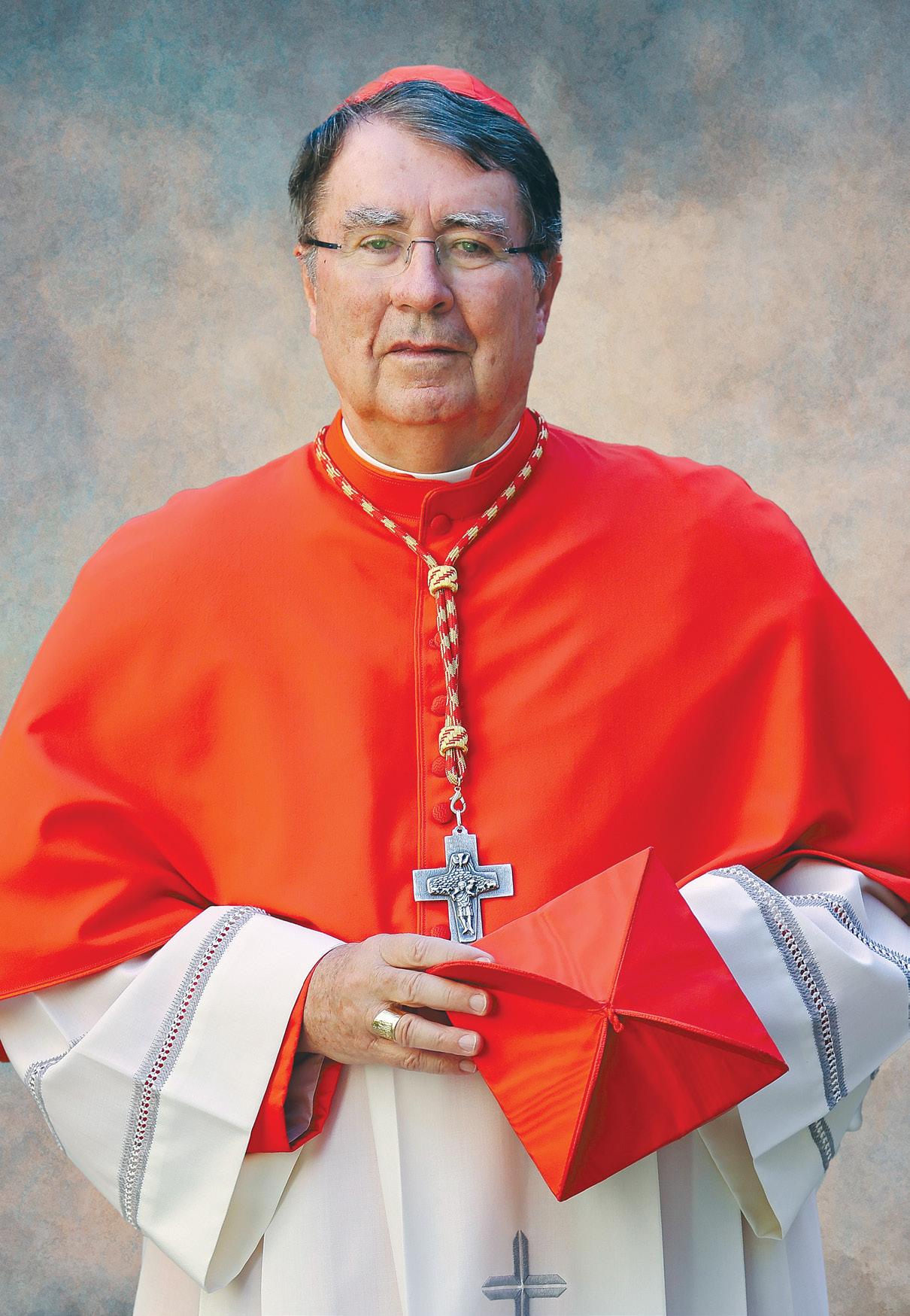
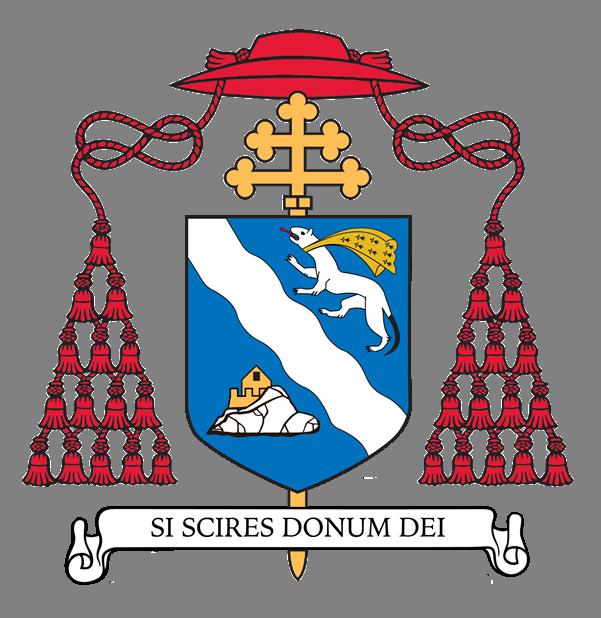




Letter from the Minister General, Fr. Carlos Trovarelli, OFM Conv., the 120th Successor of St. Francis of Assisi



Bishop Michael T. Martin, OFM Conv., was born on Dec. 2, 1961, in Baltimore, Maryland, the only boy of four children in a Catholic family whose faith was an integral part of their lives. He attended Archbishop Curley High School in Baltimore, where he would later return to work. In 1979, when he was 17, he entered the Conventual Franciscan Friars Novitiate in Ellicott City, Maryland. He graduated with a bachelor’s degree in philosophy from St. Hyacinth College-Seminary (Massachusetts), earned a Bachelor of Sacred Theology from the Pontifical University of St. Bonaventure (Rome), and received a master’s degree in education from Boston College. He worked as a religious studies teacher and coach at St. Francis High School in Athol Springs, New York, in 1984-1985, then served as a transitional deacon at St. Adalbert Parish in Elmhurst, New York, in 1988-1989.
He was ordained to the priesthood on June 10, 1989, by then-Auxiliary Bishop John Ricard of the Archdiocese of Baltimore.
Following ordination, he returned to St. Francis High School to serve as admissions director and as a teacher and coach, from 1989 to 1994. He then served in several positions at his alma mater Archbishop Curley High School from 1994 to 2010 – including president, principal, admissions director, and teacher and basketball coach.
In 2007 he was the recipient of the Pro Ecclesia et Pontifice award from then-Pope Benedict XVI for his service to the Church.
He is no stranger to North Carolina, having served as director of the Duke Catholic Center – the official Catholic community at Duke University in Durham – from 2010 to 2022.
He has also held a number of leadership positions in the Church, particularly in Catholic education. He has served on multiple Catholic school boards including Cardinal Gibbons High School in Raleigh, and worked with Partners in Mission, a Boston-based consulting firm that partners with Catholic schools and institutions to advance the mission of Catholic education.
In 2022, his order assigned him to ministry in the Archdiocese of Atlanta, where he served as pastor of St. Philip Benizi Parish in Jonesboro, Georgia, until his episcopal appointment.

The Miter (pronounced /ˈmīdər/)
The tall headdress worn by bishops and senior abbots as a symbol of office, tapering to a point at front and back with a deep cleft between. It has its roots in the imperial crown worn by Byzantine emperors as a sign of office. The first written mention of it is found in the 11th century. In his book “The Twofold Mystery: On Christian Conversion” (pp. 100-101), Trappist cleric Erik Vardon writes: “He (the Bishop/Abbot) should always strive to live by and communicate God’s Word, loving and breathing the Scriptures. I learnt recently that this is what the miter signifies. Its two lappets (the decorative flaps that hang from the rear of the miter) stand for the Old and New Testaments, its domed shape for God’s all-containing Word. Far from elevating its bearer, as if it were an Oriental crown, it reminds him that he is a man submitted to authority, obliged at all times to practice St. Benedict’s ausculta (injunction), ‘Listen, my son!’, then to obey.”
The Crosier (pronounced /ˈkrōZHər/
The hooked staff carried by a bishop as a symbol of his pastoral office. Resembling a shepherd’s crook, the crosier is a symbol of Jesus, the Good Shepherd (John 10:11). Possibly derived from the ordinary walking stick, the crosier was first mentioned as a sign of a bishop’s office in 633. It is used by the bishop only in his own diocese and usually has the curved part of the staff facing the people whom he serves and shepherds. Bishop Martin’s crosier has been designed by one of his Franciscan brothers, Father Joseph Dorniak, OFM Conv., and is being crafted by another Franciscan, Father Peter Tremblay, OFM Conv. The design is of a wooden staff with the open space in the crook containing a circle of woven cord with the three tied knots symbolizing the vows of poverty, chastity and obedience. Since it will not be ready in time for the ordination, Bishop Martin will use the crosier of The Cathedral of St. Patrick.
The episcopal ring, worn on the fourth finger of the right hand, is a sign of a bishop’s fidelity to and nuptial bond with the Church. The first recorded mentions of a ring as a symbol of the office of bishop are from the 7th century. Bishop Martin’s ring, made of gold taken from his father’s high school ring, was crafted by his longtime friend Paul Winicki and his team at Radcliffe Jewelers in Baltimore. Its design features the bow of a fishing skiff such as the apostles would have used (Lk 5:4), with the keel forming a Tau cross at its top.

A cross worn by the pope, cardinals, bishops and abbots on the chest (pectoralis) attached to a chain or silken cord. The first mention made of the pectoral cross as part of this pontifical ornament is in the 13th century, and its use as such only became customary toward the close of the Middle Ages. The pectoral cross symbolizes the order of dignity of the office of bishop or abbot and distinguishes them from other clergy.
(pronounced /zooˈkedō/)
The zucchetto is a small, closely-fitting skullcap that Roman Catholic prelates have worn since the 13th century. It originally protected the head bared by the tonsure, a hairstyle in which the center of the scalp was shaved as a sign of humility and piety. The color of the zucchetto indicates the wearer’s rank, with the pope wearing white, cardinals wearing scarlet, and bishops wearing amaranth red (a shade of purple).
A bishop’s Coat of Arms is the emblem of the bishop and is used on documents, letterheads, and other official publications. It consists of a shield with symbols representing the bishop and his office. The left side of the shield is taken from the diocese where he serves and the right side of the shield is made of symbols that are particular to him. The shield is surrounded by ornamentation that consists of a gold processional cross in back of and extending above and below the shield, and a pontifical hat called a galero, with six tassels in identical rows of one, two and three on either side of the shield, all in green (the original color bishops wore). For a description of Bishop Martin’s Coat of Arms, please see the next page.
A bishop’s motto is a short phrase that reflects his personal faith and is featured on his coat of arms. The motto is usually a passage from Scripture or a phrase, and is an integral part of the bishop’s ministry. Bishop Martin has chosen as his motto “Duc in Altum” (“Put Out Into the Deep”), a phrase from Luke 5:4, as an invitation to all the faithful to respond to Jesus’ challenge to continuously explore the depths of discipleship to which we have all been called. Regardless of our age, state in life, knowledge of or commitment to Jesus, He always invites us deeper and always graces us with an even greater blessing/catch.

The formal blazon of the heraldic achievement of the Most Reverend Michael T. Martin, Bishop of Charlotte: Arms impaled. Dexter, Arms of the Diocese of Charlotte, that is: per fess vert and azure, a Celtic Cross argent, a crown or; Sinister: Personal Arms of Bishop Michael T. Martin, OFM Conv., that is: Tierced per fess; the first, Paly of six Or and Sable a bend counterchanged; the second, the arms of the Franciscan Order, that is: upon a Tau cross Proper two arms in saltire, the one to dexter uncovered and the one to sinister habited of the Conventual Franciscan Friars, both hands displaying the Stigmata, all Proper; the third same as the first.
Bishop Martin’s Coat of Arms has the outline of a San Damiano Cross at the top of the processional cross. This is the cross that spoke to St. Francis of Assisi in 1205, saying to him: “Go, repair my Church for it is falling into ruin.”
The left side of the shield contains the emblems of the Diocese of Charlotte: a Celtic Cross as an homage to The Cathedral of St. Patrick, and a crown in reference to Charlotte as “the Queen City” in honor of Charlotte of Mecklenburg-Strelitz (1744–1818), queen consort of British King George III during the time of the city’s founding.
The right side of the shield has the Franciscan coat of arms at the center: an image of the crossed arms with nail wounds in the hands – one representing Christ and the other St. Francis of Assisi, who bore the Stigmata (wounds of Christ). There is also a form of the cross often depicted as the letter “T.” It is actually a “Tau,” the last letter of the Hebrew alphabet. St. Francis of Assisi made the Tau his own and was known to even end letters by signing them with a T. This Franciscan symbol is centered within a field of black and gold, a quarter of the coat of arms of George Calvert and his son Cecil Calvert, the first and second Barons of Baltimore. Both were Catholics, with Cecil establishing the then Province of Maryland (Bishop Martin’s home state) as a proprietary colony for English Catholics who were no longer able to practice their faith freely at home.
The bottom of the Coat of Arms features the Bishop’s Motto “Duc in Altum,” Latin for “Put Out Into the Deep,” from Luke 5:4.
The Coat of Arms was designed by his former student, Brian Taberski, an education professor at Seattle University.
Impalement is a heraldic practice in which two coats of arms are combined in one shield to denote a union. The impaled shield is bisected in pale – that is, by a vertical line – with each half of the shield displaying one coat of arms.
For Bishop Martin, his personal Coat of Arms (at far right) is impaled, or combined, with the Arms of the Diocese of Charlotte, to form his official Coat of Arms as the Fifth Bishop of Charlotte (on opposite page).
Before Mass
Multilingual Rosary
Please join in reciting the Glorious Mysteries of the Holy Rosary starting at 12:15 p.m., led by Deacon Kevin Martinez. Each decade will be prayed in a different language:
1 – The Resurrection ................................................................. English .................. Sarah Martin
2 – The Ascension ..................................................................... Spanish ................. Olga Lucia Villar
3 – The Descent of the Holy Spirit ........................................... Vietnamese ........... Nancy Tran
4 – The Assumption .................................................................. Korean .................. Koo, Kyung Tae
5 – The Coronation of Mary as Queen of Heaven................... Tigrinya ................ Asmeret Tewelde
Pray along on a set of rosary beads, or scan this QR code to pray along on your mobile device:

Preludes
Sonata 11 in G – Giovanni Battista Vitali (1632-1692)
Fanfare for the Common Man – Aaron Copland (1900-1990)

Please stand for the Entrance Procession and the Introductory Rites.
Processional • Procesional
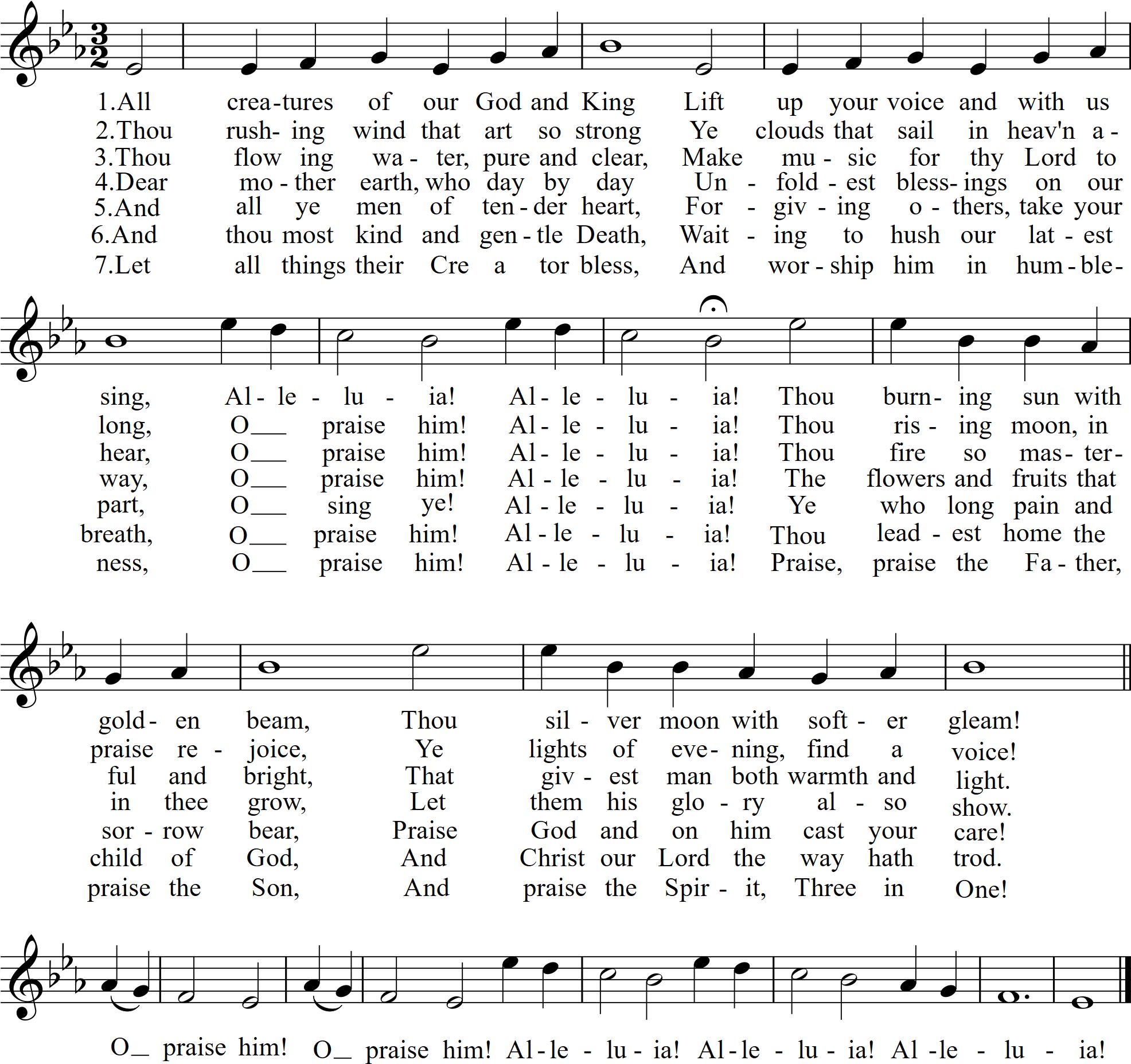
Introit • Introito
Dominus Fortitudo Plebis Suae – Ps. 29:8, 9; Plainsong, Mode II
Dominus, fortitudo plebis suae, et protector salutarium
Christi sui est: salvum fac populum tuum, Domine, et benedic hereditati tuae, et rege eos usque in saeculum. (Ps. 28:1) Ad te, Domine, clamabo, Deus meus, ne sileas a me: nequando taceas a me, et assimilabor descendentibus in lacum.
The Lord is the strength of His people, and the protector of the salvation of His anointed: save, O Lord, your people, and bless your inheritance, and rule them forever. (Ps. 28:1) Unto you will I cry, O Lord: O my God, be not silent to me, lest if You be silent to me, I become like them that go down into the pit.

Sign of the Cross and Greeting • Señal de la Cruz y Saludo
PenItential Act • Acto Penitencial

Music © 1978, OCP Publications. All rights reserved.

Please be seated for the Liturgy of the Word.
First Reading • Primera Lectura Is 61:1-3abcd
The first reading will be proclaimed in English. A Spanish translation is provided below:
El espíritu del Señor está sobre mí, porque me ha ungido y me ha enviado para anunciar la buena nueva a los pobres, a curar a los de corazón quebrantado, a proclamar el perdón a los cautivos, y la libertad a los prisioneros; a pregonar el año de gracia del Señor, el día de la venganza de nuestro Dios. El Señor me ha enviado a consolar a los afligidos, los afligidos de Sión, a cambiar su ceniza en diadema, sus lágrimas en aceite perfumado de alegría y su abatimiento, en cánticos.
Palabra de Dios.
R. Te alabamos Señor.
Responsorial Psalm • Salmo Responsorial Ps 100:1b-2, 3, 4, 5
Sing joyfully to the Lord, all you lands; serve the Lord with gladness; come before Him with joyful song. R.
Know that the Lord is God; He made us, His we are; His people, the flock He tends. R.
Enter His gates with thanksgiving, His courts with praise; Give thanks to Him; bless His name. R.
R. Ustedes son mis amigos si hacen lo que Yo les mando.
For He is good: The Lord whose kindness endures forever, and His faithfulness, to all generations. R.
Aclame al Señor toda la tierra, sirvan al Señor con alegría, lleguen hasta él con cantos jubilosos. R. Reconozcan que el Señor es Dios: él nos hizo y a él pertenecemos; somos su pueblo y ovejas de su rebaño. R. Entren por sus puertas dando gracias, entren en sus atrios con himnos de alabanza, alaben al Señor y bendigan su Nombre. R. ¡Qué bueno es el Señor! Su misericordia permanece para siempre, y su fidelidad por todas las generaciones. R.
Second Reading • Segunda Lectura 2 Tim 1:6-14
The second reading will be proclaimed in Spanish. An English translation is provided below:
Beloved: I remind you to stir into flame the gift of God that you have through the imposition of my hands. For God did not give us a spirit of cowardice but rather of power and love and self-control. So do not be ashamed of your testimony to our Lord, nor of me, a prisoner for His sake; but bear your share of hardship for the Gospel with the strength that comes from God. He saved us and called us to a holy life, not according to our works but according to his own design and the grace bestowed on us in Christ Jesus before time began, but now made manifest through the appearance of our savior Christ Jesus, who destroyed death and brought life and immortality to light through the Gospel, for which I was appointed preacher and Apostle and teacher. On this account I am suffering these things; but I am not ashamed, for I know Him in whom I have believed and am confident that He is able to guard what has been entrusted to me until that day. Take as your norm the sound words that you heard from me, in the faith and love that are in Christ Jesus. Guard this rich trust with the help of the Holy Spirit that dwells within us.
The word of the Lord.
R. Thanks be to God.
Please stand for the proclamation of the Gospel.
Gospel Acclamation • Aclamación antes del Evangelio

Gospel • Evangelio Jn 21:15-17
The Gospel will be proclaimed in English. A Spanish translation is provided below: + Lectura del Santo Evangelio según Juan
Habiéndose aparecido Jesús a sus discípulos, después de comer, dijo a Simón Pedro: “Simón, hijo de Juan, ¿me amas más que estos?” Él le respondió: “Sí, Señor, tú sabes que te quiero.” Jesús le dijo: “Apacienta mis corderos.” Le volvió a decir por segunda vez: “Simón, hijo de Juan, ¿me amas?” Él le respondió: “Sí, Señor, sabes que te quiero.” Jesús le dijo: “Apacienta mis ovejas.” Le preguntó por tercera vez: “Simón, hijo de Juan, ¿me quieres?” Pedro se entristeció de que por tercera vez le preguntara si lo quería, y le dijo: “Señor, tú lo sabes todo; sabes que te quiero.” Jesús le dijo: “Apacienta mis ovejas.”
Palabra del Señor.
R. Gloria a Ti, Señor Jesús.
Please remain standing for the blessing with the Book of the Gospels, followed by the hymn “Veni Creator Spiritus.”

At the beginning of the Rite of Ordination, before all else, the Church implores the power and presence of the Holy Spirit through this ancient hymn.
Veni, Creator Spiritus (“Come, Creator Spirit”)

Please remain standing for the Presentation of the Elect.
The bishop-elect is presented to the consecrating bishop and the congregation by two assisting priests, who ask the consecrating bishop to ordain the bishop-elect in the name of the local Church.
Please be seated for the reading of the Apostolic Letter, followed by the Homily.
The apostolic letter from Pope Francis is read aloud by Christophe Cardinal Pierre, apostolic nuncio (ambassador) to the United States. This letter testifies to the Holy Father’s choice of Father Martin for ordination to the episcopate, the third and final “degree” of the sacrament of holy orders.
After the document is read, everyone present gives their assent to the election of the bishop by saying: “Thanks be to God.”

After the homily, the bishop-elect publicly makes nine solemn promises to God and to the Church, that: (1) he is prepared to discharge this sacred duty until the end of his life, (2) he will remain “faithful and constant” in proclaiming the Holy Gospel, (3) he will maintain without change the “deposit of faith” that the apostles have passed along down through the ages, (4) he will “build up the Church as the Body of Christ,” (5) he will “remain united to it within the Order of Bishops under the authority of the successor of the Apostle Peter,” (6) he will guide the People of God “as a devoted father,” (7) he will “be welcoming and merciful to the poor,” (8) he will “seek out the sheep who stray,” and (9) he will pray unceasingly for the People of God.

The principal consecrator invites everyone to stand and pray for the bishop-elect, who prostrates himself as a sign of complete surrender to God while the entire congregation sings the Litany of Supplication (often called the Litany of the Saints) to seek the intercession of the saints. At the invitation of the deacon, please kneel.

At the invitation of the deacon, please stand.
By ancient tradition three bishops confer the sacrament of ordination. The principal consecrator, followed by the two coconsecrators, lays hands upon the head of the bishop-elect. With apostolic authority, they call down the Holy Spirit upon the new bishop. You are invited to pray silently during this solemn moment.
Then, the Book of the Gospels is opened and placed over the head of the bishop-elect by two deacons, while the principal consecrator offers the Prayer of Ordination together with all the consecrating bishops. This illustrates that the preaching of the Word of God is the “pre-eminent obligation of the office of the Bishop.” At the conclusion of the Prayer of Ordination, all say, “Amen.”
Please be seated for the Anointing of the Head and the Handing On of the Book of the Gospels and the Insignia.
Anointing of the Head and the Handing On of the Book of the Gospels and the Insignia • Unción de la Cabeza y entrega del Libro de los Evangelios y de las Inignias
The bishop is anointed with sacred chrism on the head, signifying the anointing of the Holy Spirit and the bishop’s distinctive share in the priesthood of Jesus Christ. Then the bishop is presented with the symbols of his new office:
•The Book of the Gospels, which had been held over the head of the bishop during the Prayer of Ordination, illustrates the importance of his faithful preaching of the Word of God.
•The Ring symbolizes his fidelity to the Church, the Bride of Christ.
•Investiture with the Miter signifies his resolve to pursue the crown of holiness.
•The Crosier (pastoral staff) symbolizes the shepherd’s staff and the bishop’s duty to guide and govern the flock entrusted to him, following the example of Jesus the Good Shepherd.
Seating of the New Bishop • Entronización del Obispo
Please stand as the new bishop now takes the first place among the concelebrating bishops.
of Peace • Beso de Paz
Before the Mass continues, the Rite of Ordination ends with the customary kiss of peace from the principal consecrator and all co-consecrating bishops present, which seals, so to speak, the new bishop’s admittance into the College of Bishops, the successor to the Apostles.
The Profession of Faith is omitted. Please be seated for the Liturgy of the Eucharist.

Preparation of the Altar and the Gifts • Preparación del Altar de las Ofrendas
Offertory Antiphon • Antífona del Ofertorio
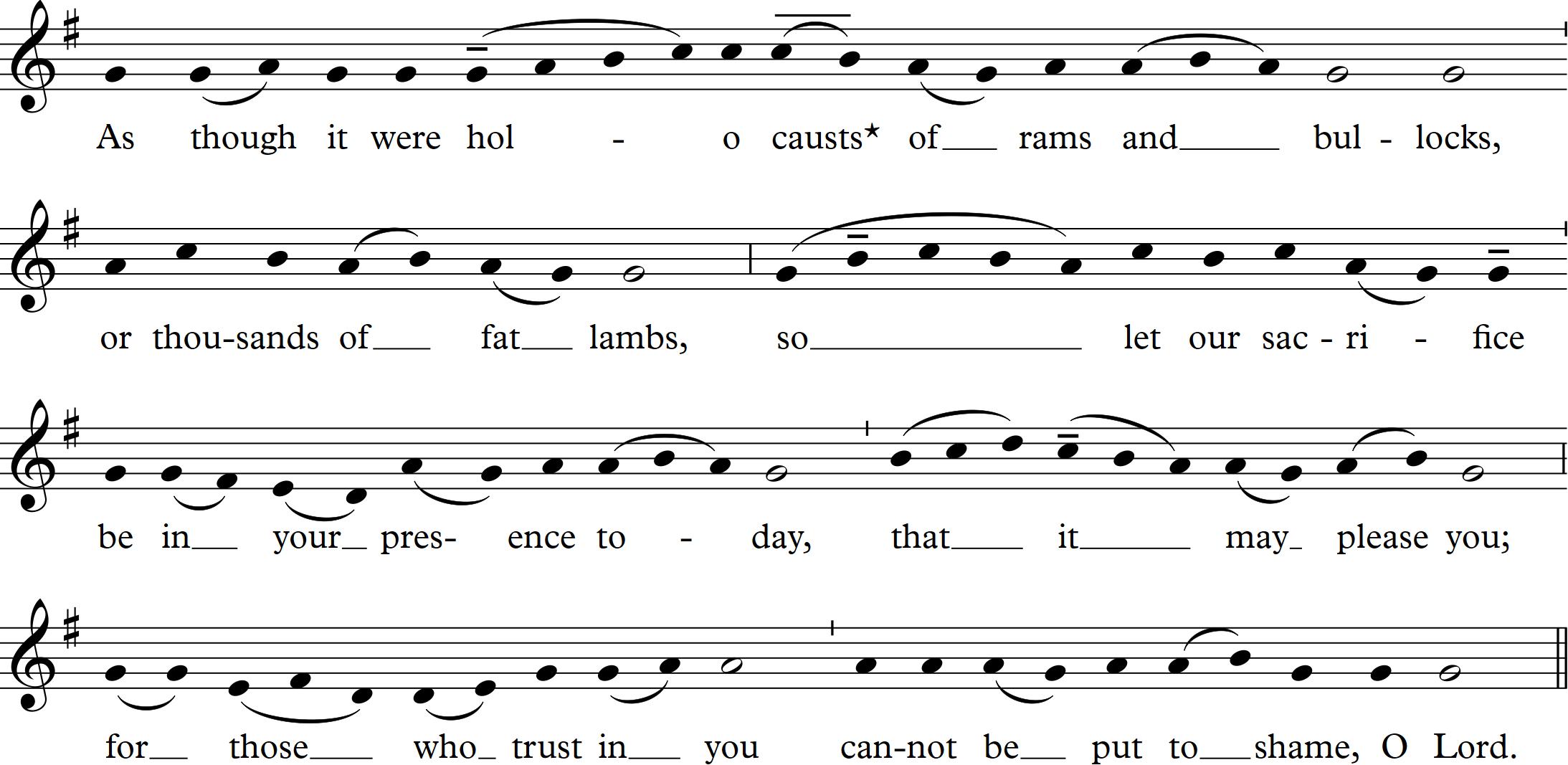

Offertory Motet • Motete del Ofertorio
Exaltabo Te – Valentin Rathgeber (1682-1750)
Exaltabo te Domine, quoniam suscepisti me nec delectasti inimicos meos super me. Domine clamavi ad te et sanasti me.
I will extol you, O Lord, for you have drawn me up: and not made my foes to triumph over me. O Lord my God, I cried unto you: and you have healed me.
After the priests stand for incensation, at the invitation of the deacon, please stand for incensation. Please remain standing for the Preface and the Sanctus.
Preface • Prefacio
Sanctus (“Holy”) • Santo

© 2010, ICEL. All rights reserved. Used with permission. Music: © 1978, 2009, OCP. All rights reserved.
Please kneel for the Eucharistic Prayer.
Eucharistic Prayer • Plegaria Eucarística
Memorial Acclamation • Aclamación Conmemorativa

Text: © 2010, ICEL. All rights reserved. Used with permission. Music: © 1988, 2009, OCP. All rights reserved.
Amen • Amén

Music: © 1988, OCP Publications. All rights reserved.

Please stand for the Lord’s Prayer, the Sign of Peace, and the Agnus Dei. At the conclusion of the Agnus Dei, please kneel.
Lord’s Prayer • Padre Nuestro
Sign of Peace • Rito de la Paz
Breaking of the Bread • Fracción del Pan
Agnus Dei (“Lamb of God”) • Cordero de Dios

Holy Communion will be distributed at several locations inside the church and parish hall. Please follow the usher’s instructions. Those who wish to receive a low-gluten Host should approach the right or left side of the altar.
As Catholics, we fully participate in the celebration of the Eucharist when we receive Holy Communion. We are encouraged to receive Communion devoutly and frequently. In order to be properly disposed to receive Communion, participants should not be conscious of grave sin and normally should have fasted for one hour. A person who is conscious of grave sin is not to receive the Body and Blood of the Lord without prior sacramental confession.
We welcome our fellow Christians to this celebration of the Eucharist as our brothers and sisters. We pray that our
Communion Chant • Canto de Comunión
Simon Joannis – Plainsong, Mode VI; Jn. 21:15, 17
Simon Joannis, diligis me plus his? Domine, tu omnia nosti: tu scis, Domine, quia amo te.
common baptism and the action of the Holy Spirit will draw us closer to one another. Because Catholics believe that the celebration of the Eucharist is a sign of the reality of the oneness of faith, life and worship, members of those churches with whom we are not yet fully united are ordinarily not admitted to Holy Communion.
For anyone unable to receive Holy Communion, you are invited to come forward and receive a blessing during Holy Communion. To do this, cross your arms over your chest as you approach the clergy who are distributing Holy Communion.
Simon, son of John, do you love me more than these?” “Lord, you know all things, you know, O Lord, that I love you.”
Communion Antiphon • Antífona de Comunión

Communion Motets • Motetes de Comunión
Total Praise – Richard Smallwood (b. 1948) by Our Lady of Consolation Parish Choir
Tantum Ergo – Charles Marie-Widor (1844-1937)
Tantum ergo sacramentum veneremur cernui, Et antiquum documentum novo cedat ritui; Praestet fides supplementum sensuum defectui. Genitori Genitoque laus et iubilatio, Salus, honor, virtus quoque sit et benedictio; Procedenti ab utroque compar sit laudatio.
Therefore so great a Sacrament let us fall down and worship, And let the old law give way to a new rite, And let faith stand forward to make good the defects of sense.
To the Father and the Son be praise and joy, Health, honor and virtue and blessing, And to him proceeding from both be equal praise.
Communion Hymns • Cantos de Comunión
Señor Tu Eres El Pan
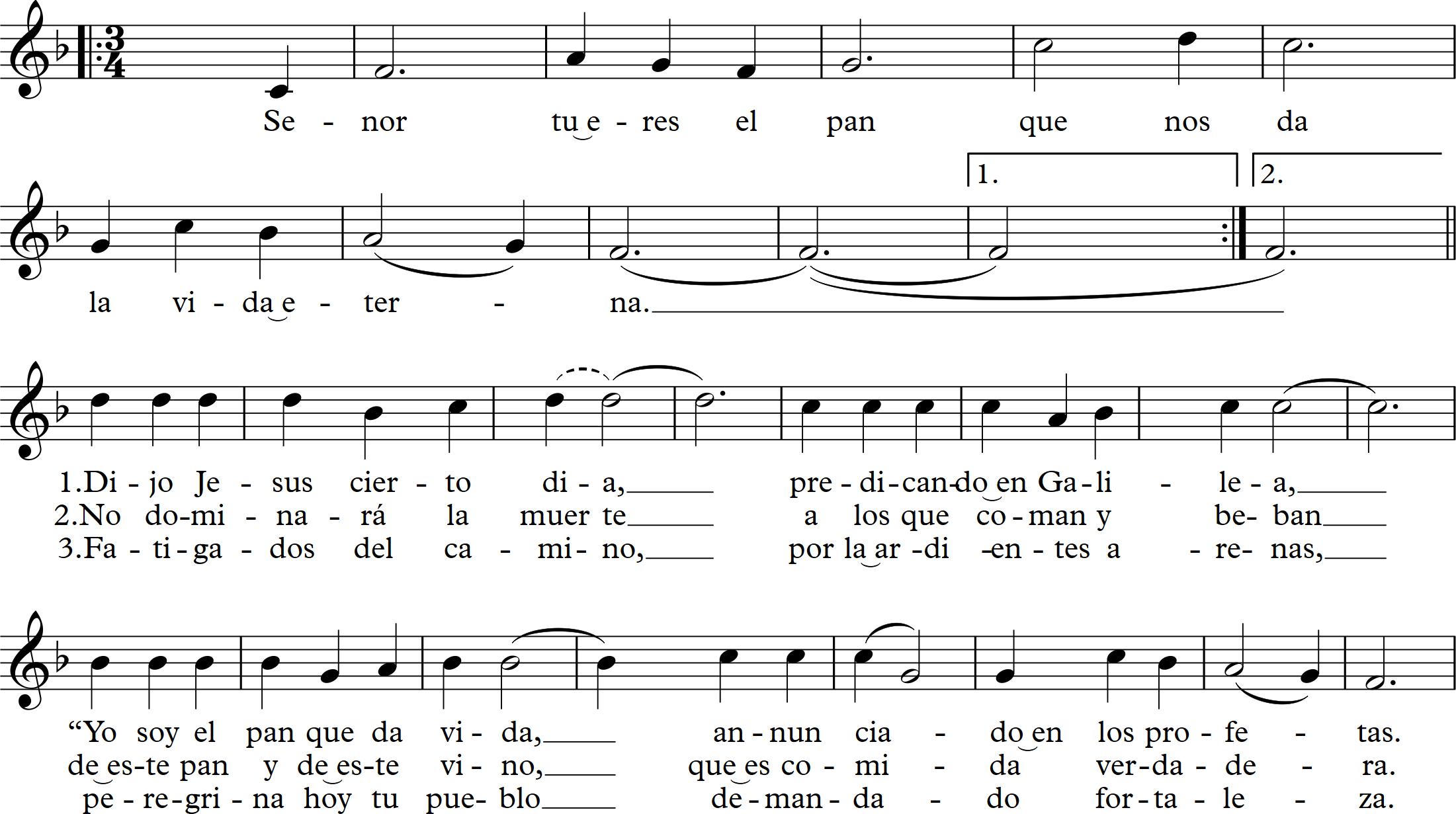
Let All Mortal Flesh Keep Silence

Prayer After Communion • Oración despues de la Comunión

The new bishop is led through the congregation to impart his episcopal blessing upon everyone present while the ancient hymn, the Te Deum (You Are God We Praise You), is sung in celebration. Please remain in your pew until the new bishop returns to the sanctuary to give the final blessing before the dismissal by the deacon to conclude Mass.



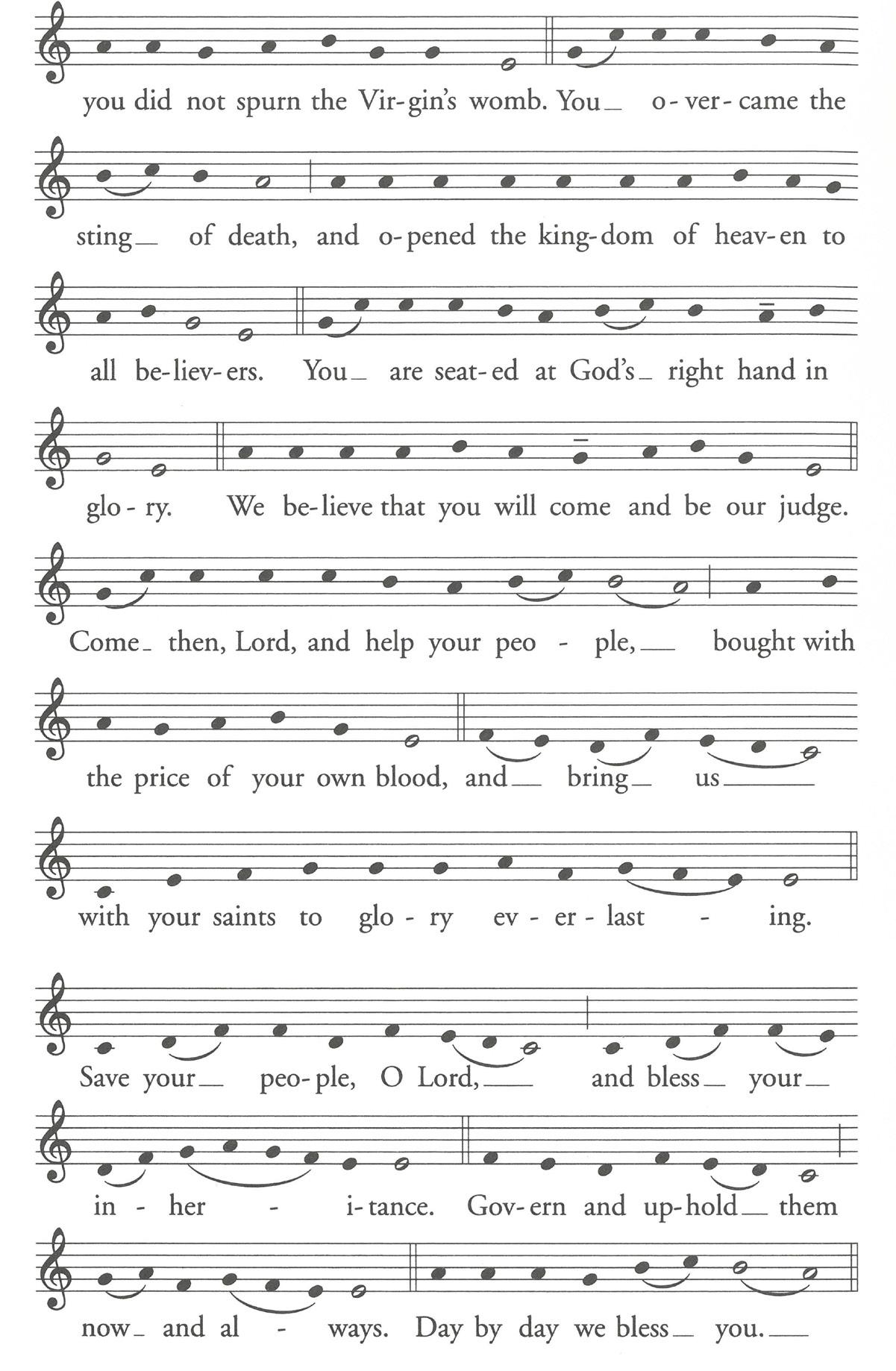


Please stand for the recessional hymn and remain in your pew until the end of the recessional. After Mass, please join fellow worshipers and clergy outside for light refreshments and fellowship.

Lord, You Give the Great Commission
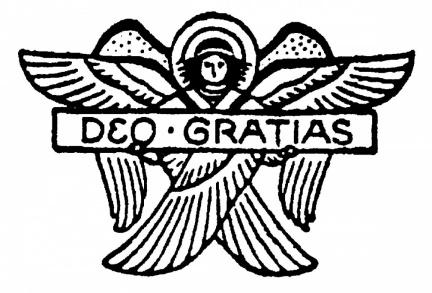
The Heritage Mass Copyright © 1987, 2009, Oregon Catholic Press. All rights reserved. Reprinted under OneLicense.net A-720276. Litany of the Saints Copyright © John Becker, 1987, 2010. Published by Oregon Catholic Press. Reprinted under OneLicense.net A-720276. The Offertory Antiphon is by Fr. Paul Arbogast, Copyright © 1964, WORLD LIBRARY OF SACRED MUSIC, Inc., Cincinnati, Ohio, 45214. Reprinted under OneLicense.net A-720276.
The Communion Antiphon and Te Deum are from By Flowing Waters: Chant for the Liturgy, Copyright © 1999 by Paul F. Ford. All rights reserved. Published and administered by The Liturgical Press, Collegeville, Minnesota 56321. Used with permission. Lord You Gave the Great Commission Copyright © 1970, 1978, Hope Publishing Co. All rights reserved. Reprinted under OneLicense.net A-720276.
If the only prayer you ever say in your entire life is thank you, it will be enough. — Meister Eckhart
The discipline of gratitude is the explicit effort to acknowledge that all I am and have is given to me as a gift of love, a gift to be celebrated with joy. — Henri Nouwen
I am so grateful to God who has brought me to this moment of grace. I am blessed by so many who have done so much to make these days so filled with joy:
• To Pope Francis for calling me to serve the Church of Charlotte;
• To Christophe Cardinal Pierre, Papal Nuncio to the United States, for serving as a Co-Consecrator and guiding me to this moment;
• To Archbishop Gregory Hartmayer, OFM Conv., Principal Consecrator, brother and mentor;
• To Bishop Emeritus Peter Jugis, for serving as Co-Consecrator and for welcoming me to Charlotte;
• To the Bishops, Priests, Deacons and Religious who join us here today and via livestream for your continued commitment to Christ in the Church;
• To my Conventual Franciscan brothers who have formed, nurtured and shared life with me for 45 years – you are and will always be for me an inspiration as the lived incarnation of the Franciscan ideal.
• To Father Michael Heine, OFM Conv., Minister Provincial of the Conventual Franciscans of OLA Province, and to Father Jude Michael Krill, OFM Conv., for serving as Priest Attendants today, and more importantly for walking with me in faith and fraternity for most of my life;
• To Brother Joseph Wood, OFM Conv., Assistant General of the Conventual Franciscans, representing our Minister General and so wonderfully leading my episcopal retreat;
• To Very Rev. John Putnam, Pastor, the staff and people of St. Mark Parish for your hospitality and willingness to host these festivities;
• To Very Rev. Christopher Roux, Father Juan Miguel Sanchez and Father Gerardo Ceballos-Gonzalez, the Masters of Ceremonies, Seminarian altar servers, and all those who have facilitated these moments of prayer and praise;
• To Dr. Gianfranco DeLuca, and all of the Music Ministers who helped raise our hearts and voices in song;
• To Civic and Interfaith Leaders who have blessed us with their presence and support;
• To Monsignor Patrick Winslow, and all of the Pastoral Center Staff who coordinated all of the infinite number of details to bring us together for these days of celebration of faith, especially Michelle Maher without whom none of this would have been possible;
• To all those to whom I have had the honor of serving at St. Adalbert’s, St. Francis, Archbishop Curley, Duke, and most recently, St. Philip Benizi – you have given me more than I am sure I have given you;
• To my family who means so much to me, those here today, those who cannot be here, and those who celebrate with us before the throne of God’s glory – you are the foundation of my life that has enabled me to come to know Jesus in the untold ways that I see Him in you;
• To my newest and best 500,000 Catholic brothers and sisters in Western North Carolina with whom I am honored to walk in faith and to whom I am pledged to serve;
May you all know of my love for each of you and my promise to pray that the Holy Spirit will fill you with gifts that He shares with all of us in different ways but for one purpose – the praise and glory of God! + Mike